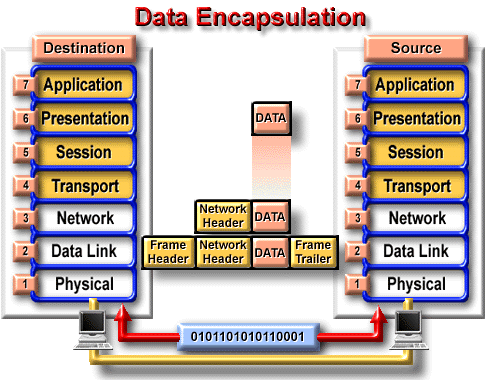Home | Models | OSI Model pg1 | OSI Model pg2 | Another OSI Model
OSI Model - Page 3
At the receiving end, the data would subsequently by de-encapsulated, layer by layer in the opposite direction. For example, the receiving station would receive the data stream and pass it up to the data link layer.1. If this station noticed that its MAC address were the destination MAC address, it would know that it has to pay attention and process the packet, striping off the data link header and passing it up to the network layer. If not, it would simply discard the packet at this point.
2. Next, it will pass the packet up to the Network Layer. At this point, it will determine whether the destination IP address is its IP address. If so, it will strip off the network header and pass it up to the transport layer. You should note that just because the MAC address belongs to the system, it doesn't necessarily mean that the IP address does as well. For example, a router will receive many packets with its MAC address and different IP destination addresses, a subject we will cover - once we get into routing.
3. Once the packet has been passed up to the Transport layer, it is definitely destined for this system. This layer will take a look at the destination port listed in the header, strip the header, and then pass the data to the appropriate application that is waiting for the data, assuming that application exists (it may not - imagine a request for a web page from a system not running as a web server)
Note that at each point in the process, a layer only looks at the information added by its equivalent layer at the sending machine. This is known as a peer-to-peer relationship between the OSI layers on the source and destination machines. To that end, the only layers that a given layer ever interacts with are the equivalent layers on other systems, as well as the layers directly above and below it on the same system. The fact that layers are independent of each other is another design goal of the OSI model - changing a given layer should not effect other layers in the model
One last note with respect to the encapsulation process described in these Study Guides. As each layer changes the data, the reference name for that data unit is changed. "Packet" is a generic name often used to describe the unit at any stage of the process. However, the following terms are used by Cisco to describe data at different network layers:
Data units above the Transport layer = User Data
Transport layer data units = Segments
Network layer data units = Datagrams or Packets
Data Link layer data units = Frames
Physical layer data units = Bits
To help remember them in the correct order, I use this mnemonic:
You
Don't
Dare
Send
PaDy
For
Beer
Taken from my college days when my Irish friend was given our money to go buy beer.
Often he did not return with our drinks. So sad!
This mnemonic represents:
Data at the top 3 Layers
Segments at the Transport/4th Layer
Packets or Datagrams at the Network/3rd Layer
Frames at the Data Link/2nd Layer, and
Bits at the Phisical/1st Layer

I have included another Study Guide about the OSI Model - take a look at it
